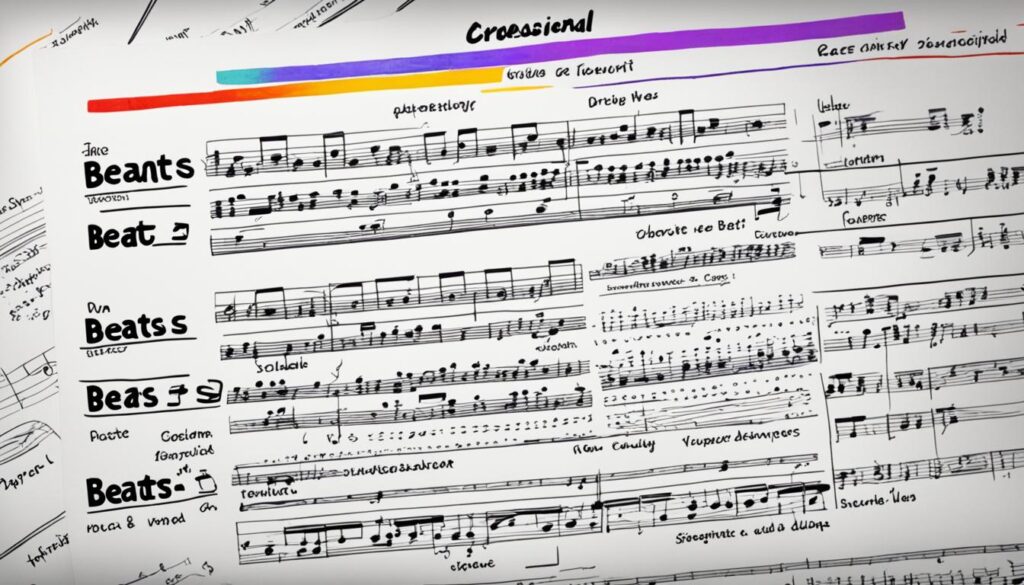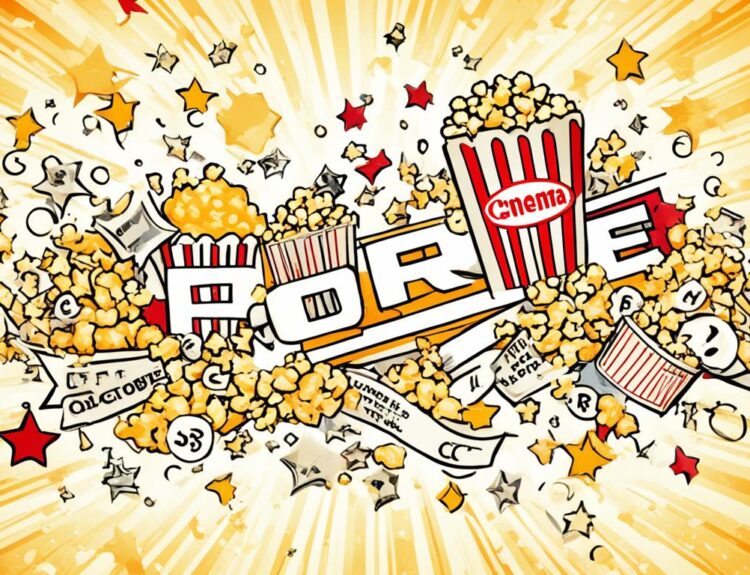Script analysis involves looking closely at the script, understanding its deeper meaning, and using it to perform better. It’s crucial for actors and directors as it helps them understand the story and the characters deeply. This understanding leads to performances that stand out.
Actors need to do more than just remember their lines. They must dive into their characters’ world. By examining the script’s words closely, noting how sentences are built, and the punctuation used, actors can find valuable clues. These clues help them bring their characters to life in a very real way.
Using AI for script analysis speeds up script breakdowns, making it faster to understand scenes, characters, and props. This tech understands the script’s language, picking up on its tone and finer points. It gives objective feedback, free from human biases.
AI also makes team work smoother. It adapts script summaries for different team members, making sure everybody understands the script well. This helps everyone on the project to work better together.
Key Takeaways
- Script analysis involves intensive research, close-reading, and interpretation.
- It helps actors and directors grasp the narrative and character arcs.
- Close reading and attention to detail can reveal crucial insights for character portrayal.
- AI tools significantly speed up pre-production and enhance script analysis with objective insights1.
- Script analysis is vital for achieving impactful and distinctive performances.
Understanding the Importance of Movie Script Analysis
To truly get what movie script analysis offers, we must see its value in understanding a script and enhancing performances. This method shows what the writer aimed to say. It also finds key insights for bringing characters to life in fresh ways.
Gaining Deeper Insights
Script analysis offers a deep look at the story, what drives characters, and the big themes. Judith Weston, a teacher since 1985, stresses its importance. She’s taught many in film and TV the power of breaking down a script2.
Her teaching over three decades has helped improve storytelling and performances2.
Enhancing Creative Performances
Looking closely at a script helps actors make their roles stand out. It lets them show off their skills in new ways.
Now, things like script analysis software and data analytics help predict what viewers will feel. This ensures performances match the story well34.
Textual Analysis: The Foundation of Effective Script Reading
Textual analysis is key in scriptwriting. It’s vital for understanding the script and how the story flows. To fully catch what the writer means, every word and punctuation needs to be considered. Looking closely at how a script is built helps us see into characters and how they talk.
Breaking Down Word Choices
In script analysis, each word matters. The words chosen can tell us a lot about what a character wants or why they act a certain way. By focusing on special words or using a dictionary for clarity, actors can really get what their lines mean and the hidden messages.5 This step is crucial in understanding the story’s direction4.
The Role of Punctuation in Scripts
Punctuation guides actors in how they should say their lines. It shapes the overall feel and timing of the spoken word. Knowing the purpose of each comma, period, or exclamation point, helps in delivering emotions and pacing.5
Noting where the tone shifts are vital. It shows where the key emotional moments lie in the dialogue5. Getting better at reading and analyzing scripts helps in catching these subtle cues4.
“Punctuation isn’t just a technical aspect of script analysis; it serves as a roadmap for an actor’s delivery, impacting everything from pacing to emotional portrayal.”
Script analysis is all about piecing together words and punctuation to make a script come alive. This approach makes sure every performance stays true to what the writer envisioned. It lays a solid base for deeply understanding and performing scripts effectively.
The Significance of Character Development Analysis
Character development analysis is key to understanding a story and its characters. It helps in creating a powerful portrayal and keeping the plot consistent. Actors and directors study character arcs to see how they change over time. This lets them connect more deeply with the audience64.
Character Arcs and Growth
Breaking down character arcs is vital in seeing how characters evolve. This process plots their journey from start to finish. It lets actors bring complex roles to life4. A well-built character arc makes the story engaging and keeps viewers hooked until the end6.
Understanding Given Circumstances
Grasping a character’s given circumstances means exploring their background, relationships, and situations. This information is crucial for a realistic portrayal. It makes the character fit convincingly within the story’s world7. Actors who dig into these details can perform in ways that touch the audience and push the story forward4.
Delving into given circumstances adds layers to character analysis. It turns script elements into powerful, real performances. This enriches the story’s authenticity and engagement74.
Plot Structure Breakdown: Mapping the Story Arc
Plot structure can be broken down into a three-part format to outline a screenplay’s story arc efficiently. This three-act structure is recognized as a simple yet powerful method for constructing stories in movies and documentaries8.
Three-Act Structure
The three-act screenplay breaks stories into three critical phases: Act I – The Setup, Act II – The Confrontation, and Act III – The Resolution9. It’s a flexible structure that helps a story unfold naturally while keeping viewers hooked. By using this framework, audiences become emotionally invested from the start, making for an engaging story8.
Plot Points and Their Impact
In Act I, important elements such as the opening scene, theme development, and the call to action are introduced9. These elements establish the world of the story and what the main characters aim to achieve. Then, in Act II, a midpoint brings key challenges—tensions rise as conflicts intensify and characters grow8.
This phase often includes steps like the Fun and Games period, a significant midpoint challenge, and the Dark Night of the Soul9.
Act III reaches the climax, marking the story’s emotional high. Here, the hero faces their toughest challenges yet and pushes towards their objectives8. The ending then resolves any loose ends, settling differences and delivering a satisfying story conclusion8.
Using this structure helps maintain a strong focus on character evolution and the story’s main arc, keeping the audience emotionally engaged8. Elements from Christopher Booker’s story archetypes and Aristotle’s Poetics illustrate that organized plots with clear points lead to a story that logically unfolds910.
Dialogue Analysis: Unpacking the Words and Emotions
Dialogue analysis is key for actors and filmmakers. It helps reveal what characters aim for and the story’s themes. This not only makes characters more real but also improves the storytelling.
Verbs and Objectives in Dialogue
When looking at scripts, the verbs in dialogue stand out. They show what a character wants and why they act as they do. For example, in *Unpacking*, even without spoken words, you can still get the character’s goals through actions11. By examining script dialogue, you can learn a lot about characters and their journeys.
The Emotional Weight of Words
Every word in a script carries emotional impact. It’s vital to get these emotions right for an authentic performance. Words shape how characters come across and the mood of a scene. In “Ex Machina,” analyzing the script shows how dialogue drives relationship dynamics and debates on artificial intelligence12. Thus, digging into word choice in a script reveals hidden tensions and feelings, making dialogue analysis crucial.
Themes Exploration: Identifying Core Messages
Looking into themes in movie scripts is key for making stories better. Themes are split into two types: thematic concept and thematic statement13. A thematic concept covers big ideas in the script. On the other hand, a thematic statement gives a clear lesson. For example, “Jurassic Park” looks at the dangers of unchecked tech progress13. It digs deep into what the film really wants to ask its watchers14.
Sometimes, filmmakers figure out their main theme after writing the whole story13. This natural process can make the message more subtle yet impactful. A big part of exploring themes is the emotional effect, or catharsis, which sticks with the viewer after the movie ends14. This emotional touch shows how themes can change how we see and feel about a story.
Common Themes in Cinema
Common themes in cinema focus on the inner battles characters and audiences must understand13. Movies like “Pulp Fiction” brilliantly look at fate versus control13. “Guardians of the Galaxy Vol. II” questions if friends can be family13. Recognizing these themes helps in breaking down characters and the story, making movies more united and appealing.
Conveying Messages Through Storytelling
Telling stories with deeper meanings is crucial for filmmakers. Successful movies take a new look at old stories, exploring complex themes that make them stand out3. Using thematic patterns and repetition helps make the main message stronger and clearer for the audience14. Plus, getting the whole team on board with these themes leads to a touching and unified movie13.
In the end, diving into themes not only improves storytelling but also makes sure the audience gets the message. By examining these key ideas carefully, filmmakers can offer deeper, and more memorable films that linger with viewers well beyond the last scene.
Symbolism Interpretation: Reading Between the Lines
Understanding symbolism in film scripts reveals deep story layers, making movies more interesting. Filmmakers use this to share complex ideas and add to the story, giving viewers a richer experience15.
Identifying Symbolic Elements
Spotting symbols means finding motifs that mean more than they show. Movies like *Parasite* and *Joker* use symbols like stones and clowns to dig deeper into characters and themes15.
How Symbolism Enhances Narratives
Adding symbolism to scripts brings stories to life by linking themes. This allows writers to share deeper meanings without direct words, helping viewers feel connected to the story15.
| Type of Symbolism | Description | Examples |
|---|---|---|
| Character Symbolism | Attributes or actions of a character representing deeper themes | The Joker’s makeup in *The Dark Knight* |
| Object Symbolism | Everyday objects carrying significant narrative weight | The spinning top in *Inception* |
| Setting Symbolism | Locations symbolizing broader themes | The mansion in *Parasite* |
| Color Symbolism | Colors conveying specific emotions or themes | Red in *Schindler’s List* |
Symbolic elements in films enrich storytelling, inviting audiences to discover deep meanings on their own15.
Creative Writing Techniques in Movie Scripts
Writing a good movie story means knowing a lot about how to write scripts. One key part is making sure people talk in a real and interesting way. This shows what characters want and how they feel. It makes scenes that people remember and care about.6 Stories need problems, or conflict, to keep things moving and make characters more interesting. Suspense keeps viewers excited and wanting to see what happens next.16
Adding motifs and themes makes the story deeper and more meaningful. These ideas connect the story and share the main message well.16 Knowing the theme can start conversations that go beyond just the story and the people in it.6 A story that builds up to an emotional high point keeps everyone hooked until it’s over.616
It’s important for characters to change or grow in a story. This change often goes along with the main idea of the movie.16 Since it can take 5-7 years to get a movie script ready, writers have to keep making their work better.17 When looking at a script, it’s good to think about if it will sell and if it fits current trends.17 Paying attention to these writing tips can lead to stories that are fun to watch and make people think.
The Role of Stage Directions in Understanding Scripts
Stage directions help us understand and bring scripts to life. They show what the writer imagines visually and behaviorally. This helps actors and directors match the script’s vision.18 By studying stage directions, the physical and emotional worlds of scenes are revealed. This leads to a story that grabs the audience.
Importance of Stage Directions
Some playwrights, like Tennessee Williams and Samuel Beckett, are famous for detailed stage directions. Tennessee Williams wrote long, detailed directions for guidance.18 Playwrights’ estates, like Beckett’s, ensure people stick to these details. This preserves the playwright’s original vision. Detailed directions help actors grasp their characters and the setting, leading to powerful performances.
Assessing Their Impact on Scenes
Understanding stage directions is key to evaluating a scene. For instance, Ibsen’s “Hedda Gabler” is often recreated exactly as he envisioned.18 These directions build the scene’s emotional and physical world. This is particularly true in queer theater.19 Directors use them to show emotions through actions and movements. This is essential for a scene to make sense.

Directors and playwrights working together is crucial. Even when they disagree, it helps the play stay true to its vision.19 British theater, for example, uses terms like “prompt side” (P) and “opposite prompt side” (OP) instead of stage-left and stage-right. These differences change how scenes are interpreted.18
| Playwright | Characteristic | Notable Example |
|---|---|---|
| William Shakespeare | Minimal Stage Directions | ‘Exit stage left, pursued by a bear’18 |
| Tennessee Williams | Highly Descriptive Directions | Stage directions in “Cat on a Hot Tin Roof”19 |
| Henrik Ibsen | Faithful Scenic Directions | Production of “Hedda Gabler”18 |
AI and Its Influence on Movie Script Analysis
AI has changed how movie scripts are analyzed, making the process faster and more accurate. Advanced algorithms allow for the rapid analysis of scripts. They provide detailed summaries quickly20. AI uses Natural Language Processing (NLP) to understand a script’s detailed nuances, including its tone and subtleties20.
AI-Powered Script Breakdown
AI tools are great at keeping script summaries consistent with the original, improving accuracy20. They can suggest different plot options after analyzing a script. This sparks new ideas for filmmakers20. AI gives an honest look at a script’s strengths and weaknesses. This feedback is crucial for developing the script further20.
Automated Script Synopsis Generation
With AI, creating initial script drafts is much quicker20. AI tools use market insights to predict a script’s success and match it with audience expectations20. They categorize script elements precisely. This helps understand the story better, improving storytelling20.
A top tool in this area is Filmustage. It works well with production management tools, making filmmaking workflows more efficient and promoting worldwide collaboration20. This combination encourages diverse ideas and new storytelling methods, pushing the film industry to exciting new levels.
Examples of Successful Script Analysis in Iconic Movies
Film analysis of iconic movies shows how screenplays become cinematic masterpieces. By studying these, we see that scripts do well when they have good structure, complex characters, and deep themes. The movie “The Big Short,” which won the best adapted screenplay in 201521, is a perfect example. Successful movies often balance humor and drama brilliantly, like “Three Billboards Outside Ebbing Missouri.” It’s known for mixing dry humor with drama better than most3.
In discussing character development, it’s clear that having layered characters is crucial. “In Bruges” is known for its characters, ranking high in crude humor within dramas3. Similarly, “Living” presents characters who are daring, smart, capable, and planned out. They reach a level of character strength that pulls the audience in deeper3. This approach is common in classic films, where strong, detailed characters engage the audience more.
Analysis of Key Scenes
Looking closely at key scenes in top movies shows what makes a screenplay work well. “The Dark Knight” and “The Bourne Ultimatum” teach us about action and adventure writing. Their scene descriptions and real dialogue heighten the drama and develop characters22. By dissecting these scenes, we learn how story flow and emotional moments work together to move the story forward.
Lessons Learned from Classics
Studying old movies teaches us about screenplay writing. Analyzing “American Beauty” and “The Truman Show” shows the value of changing character arcs and keeping themes consistent. “The Big Short” demonstrates innovative storytelling by breaking the fourth wall and using a minor character as a narrator21. Understanding these aspects of movie analysis is vital for those learning about scriptwriting and filmmaking.
To wrap up, looking at great scripts from iconic movies gives us important insights. By concentrating on how the story is built, the depth of characters, and the richness of themes, we can learn how to make screenplays that last and capture the audience’s attention.
Techniques for Finding Beats in a Script
Finding beats in a script helps us see when the story changes. It’s about noticing small changes in the story’s flow to make performances better. By doing this, actors can create truthful scenes that grab the audience’s attention.
Identifying Scene Shifts
Scene shifts mark big changes in the story. Recognizing these moments helps actors and directors see how the scene’s mood and goal change. The 40-beat technique teaches us to find these shifts, making writing and acting easier23. For more on how beats move a scene forward, check out Noam Kroll’s guide on the 40-beat method.
Using Beats to Enhance Performance
Using beats guides actors to match the script’s needs. Every script, filled with different methods, uses a beat sheet as a map for actors and writers23. The Blake Snyder Beat Sheet helps by mapping out key story parts like “Opening Image” and “Theme Stated”23. Beats keep the story real, while also letting actors add their unique touch, leading to better performances.

| Beat Element | Description |
|---|---|
| Opening Image | Sets the tone and mood for the story. |
| Theme Stated | Establishes the underlying message or theme. |
| Catalyst | Triggers the main story conflict. |
| Debate | Questions and considers the initial conflict. |
| Break Into Two | Marks the transition into the second act. |
| B Story | Introduces a secondary storyline that supports the main plot. |
| The Promise of the Premise | Shows the protagonist pursuing their goal in the new world. |
Objective and Action: Driving a Character’s Journey
Understanding what drives a character forward is key to telling a great story. Like creating SMART goals, characters need clear objectives to pursue. For example, a protagonist entering a 15K race sets a tangible goal, crucial for an engaging story24.
Establishing Clear Goals
Figuring out what a character really wants is the first step. This is similar to how people set SMART goals. Actors must consider both external and internal challenges, like bad weather or feeling scared, that block the way24.
Mapping Actions to Objectives
After setting the goals, linking actions to them is essential. This helps show how a character changes over time. For instance, in “Brittany Runs a Marathon,” each step toward running the NYC Marathon highlights a big change24.
Running over 1000 miles shows personal growth. It underlines the value of having clear, achievable goals24.
Setting goals and mapping actions help move the story and make characters feel real. Every action becomes meaningful, pushing the narrative and making the character’s journey believable.
The Benefits of Script Analysis for Actors and Directors
Script analysis brings great benefits to actors and directors, making movies better. It’s not just about reading the script. It’s about diving into its details to truly understand and share its main message with the audience. By deeply studying the script, actors and directors can fully use storytelling. This leads to more real and detailed performances and smarter decisions by directors.
Improving Actor Performances
For actors, knowing how to analyze a script is key to standing out in auditions and on stage25. This skill helps them look at different ways to say their lines and discover new meanings25. Such detailed study helps actors portray their characters more deeply, connecting with them genuinely25. Understanding why a character acts a certain way helps bring more truth to the performance25.
Aiding Directorial Decisions
For directors, script analysis is crucial in making a movie. It helps them understand characters and their journeys, affecting costumes, sets, and the story25. Directors often need actors to change how they act, based on combined ideas. This shows how important it is to be flexible and open to suggestions25. With detailed script study, directors can tell a clearer and more captivating story. They make sure every choice supports the film’s goal and boosts actors’ performances25.
Script analysis is key for better acting and directing. It lets actors and directors work closely, making the most of the script. This teamwork leads to a stronger story. For more on script analysis, check out Kimberly Jentzen’s article on script analysis benefits.
FAQ
What is the importance of movie script analysis?
How does character development analysis aid actors?
What role does textual analysis play in script reading?
How is the plot structure typically analyzed?
Can you explain the significance of dialogue analysis in scripts?
Why is theme exploration important in script analysis?
What is the role of symbolism interpretation in movies?
How do creative writing techniques contribute to movie scripts?
What is the impact of stage directions on script understanding?
How has AI influenced movie script analysis?
What can be learned from analyzing key scenes in iconic movies?
How are beats identified and used in script performance?
Why is understanding a character’s objectives and actions important?
How does script analysis benefit actors and directors?
Source Links
- https://filmustage.com/blog/ai-synopsis-technology-reshaping-film-script-analysis/
- https://medium.com/film-courage/how-professional-directors-and-actors-analyze-a-script-judith-weston-c6a1299cf40f
- https://storyfit.com/script-analysis-famous-screenplays/
- https://www.stage32.com/blog/unveiling-the-secrets-of-script-analysis-3682
- https://www.theatrefolk.com/blog/script-analysis-actors-five-steps-building-foundation
- https://www.stage32.com/blog/script-analysis-101-understanding-the-key-elements-that-make-or-break-a-screenplay-3647
- https://filmustage.com/blog/character-breakdown-mastery-essential-techniques-for-film-script-analysis/
- https://www.docfilmacademy.com/blog/master-the-art-of-documentary-storytelling-in-three-acts
- https://www.arcstudiopro.com/blog/three-act-structure-in-screenwriting
- https://www.blurb.com/blog/what-is-story-structure/
- https://absoludicrousblog.wordpress.com/2022/04/17/unpacking-the-storytelling-in-unpacking/
- https://gointothestory.blcklst.com/script-analysis-ex-machina-part-1-scene-by-scene-breakdown-25ebd7b2777d
- https://nofilmschool.com/themes-in-a-film
- https://screencraft.org/blog/3-philosophies-to-finding-your-screenplays-theme/
- https://industrialscripts.com/symbolism-examples/
- https://industrialscripts.com/literary-devices/
- https://screencraft.org/blog/how-to-write-amazing-screenplay-coverage-and-feedback/
- https://www.stagemilk.com/stage-directions/
- https://scholarsbank.uoregon.edu/xmlui/bitstream/handle/1794/25797/Final_Thesis-Peri_R.pdf?sequence=1&isAllowed=y
- https://filmustage.com/blog/ai-synopsis-technology-reshaping-film-script-analysis
- https://gointothestory.blcklst.com/script-analysis-the-big-short-scene-by-scene-breakdown-c139e19cf49e
- https://www.nfi.edu/screenplay-examples/
- https://noamkroll.com/this-simple-beat-sheet-technique-will-help-you-finish-your-feature-screenplay-in-record-time/
- https://www.stage32.com/blog/the-starting-line-understanding-character-want-and-need-2782
- https://kimberlyjentzen.com/the-benefits-of-script-analysis-by-kimberly-jentzen/





